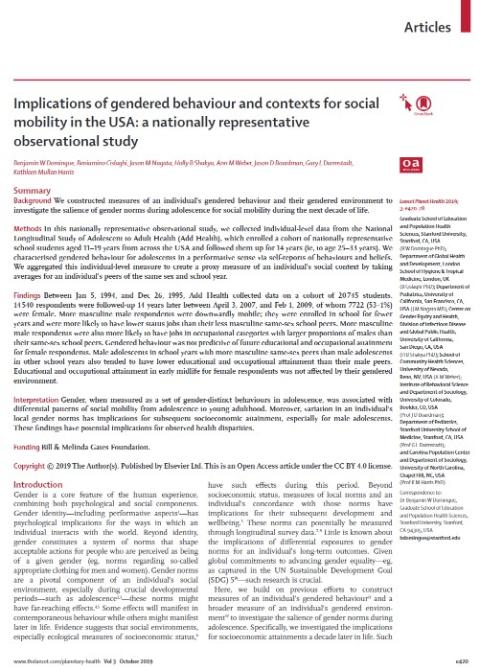- Journal article
- 16 October 2019
Implications of gendered behaviour and contexts for social mobility in the USA: a nationally representative observational study
- Author: Benjamin Domingue, Ben Cislaghi, Jason Nagata, Holly Shakya, Ann Weber, Jason Boardman, Gary Darmstadt, Kathleen Mullan Harris
- Published by: The Lancet

Summary
Background
We constructed measures of an individual's gendered behaviour and their gendered environment to investigate the salience of gender norms during adolescence for social mobility during the next decade of life.
Methods
In this nationally representative observational study, we collected individual-level data from the National Longitudinal Study of Adolescent to Adult Health (Add Health), which enrolled a cohort of nationally representative school students aged 11–19 years from across the USA and followed them up for 14 years (ie, to age 25–33 years). We characterised gendered behaviour for adolescents in a performative sense via self-reports of behaviours and beliefs. We aggregated this individual-level measure to create a proxy measure of an individual's social context by taking averages for an individual's peers of the same sex and school year.
Findings
Between Jan 5, 1994, and Dec 26, 1995, Add Health collected data on a cohort of 20 745 students. 14 540 respondents were followed-up 14 years later between April 3, 2007, and Feb 1, 2009, of whom 7722 (53·1%) were female. More masculine male respondents were downwardly mobile; they were enrolled in school for fewer years and were more likely to have lower status jobs than their less masculine same-sex school peers. More masculine male respondents were also more likely to have jobs in occupational categories with larger proportions of males than their same-sex school peers. Gendered behaviour was not predictive of future educational and occupational attainment for female respondents. Male adolescents in school years with more masculine same-sex peers than male adolescents in other school years also tended to have lower educational and occupational attainment than their male peers. Educational and occupational attainment in early midlife for female respondents was not affected by their gendered environment.
Interpretation
Gender, when measured as a set of gender-distinct behaviours in adolescence, was associated with differential patterns of social mobility from adolescence to young adulthood. Moreover, variation in an individual's local gender norms has implications for subsequent socioeconomic attainment, especially for male adolescents. These findings have potential implications for observed health disparities.
Funding
Bill & Melinda Gates Foundation.
- Countries / Regions:
- United States of America
Report
19 November 2024

Biblio/Lit. review
1 September 2024

Blog
31 August 2023
